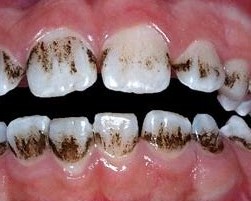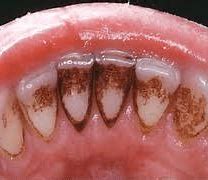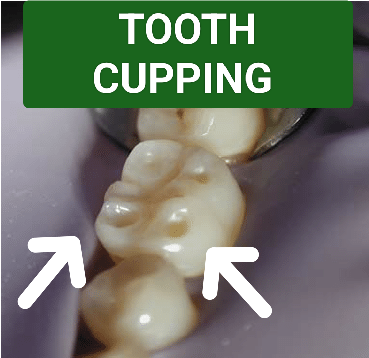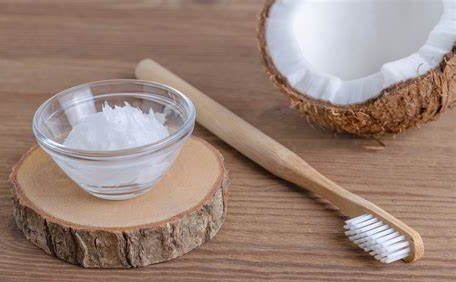What Are Dental Stains?
Dental stains refer to discolouration of the teeth that can range from minor yellowing to more severe staining that affects both the enamel and dentin. Although dental stains are often a cosmetic concern, they can also be indicative of underlying dental issues. Understanding the types of dental stains, their causes, treatment, and prevention can help you maintain a brighter, healthier smile.

Types of Stains On Teeth:
There are three basic types of dental stains:
1. Extrinsic Stains:
These occur on the outer layer of teeth, which is the enamel. They are usually caused by consuming pigmented foods and drinks such as coffee, red wine, and cola, smoking, poor oral hygiene, or using certain medications.These stains can be removed or reduced by regular brushing and professional dental cleaning.

2. Intrinsic Stains:
These occur on the inner layer of teeth, which is the dentin. They can be caused by using certain medications, excessive fluoride intake, trauma, or genetics.Intrinsic stains are more difficult to remove and may require professional bleaching or veneers to correct

3. Age-Related Stains:
These are caused by a combination of intrinsic and extrinsic factors and tend to occur naturally as the enamel layer thins with age. As people get older, their teeth may become more yellow or brown in color due to years of wear and tear and exposure to staining agents.
4. Tetracycline staining:
This is a particular type of intrinsic staining caused by the use of the antibiotic tetracycline during childhood, resulting in teeth having a grey or brown color.
5. Fluorosis:
Caused by excessive intake of fluoride in excessive amounts during tooth formation, which can cause speckled white staining on the teeth.
6. Root canal staining:
After a root canal procedure, the tooth may become darker in color because the blood supply to the tooth is altered during the procedure.
7. Acid erosion:
Acidic drinks, such as fruit juice and soft drinks can eat away the tooth enamel, leaving a white or brown discoloration behind.
It is important to note that there are also other types of dental stains that can be caused by specific conditions such as Amelogenesis Imperfecta or Dentinogenesis Imperfecta. These are genetic conditions that can cause abnormal development of the teeth and can result in discoloration or staining of the teeth.
Related Article :- What Is Professional Dental Cleaning?
What Are The Causes of Stains On Teeth?:
Dental stains can be caused by a variety of factors including:
1. Poor oral hygiene: Poor dental hygiene habits can lead to the build-up of plaque and tartar on the teeth, which can cause extrinsic staining.
2. Pigmented Foods and Drinks: Certain foods and drinks such as tea, coffee, red wine, and cola can stain the teeth when consumed regularly.
3. Tobacco use: Smoking and other forms of tobacco use can result in brownish-yellow stains on the teeth.
4. Medications: Certain medications such as tetracycline can cause intrinsic staining.
5. Age: Dental staining is more common with age, as the enamel layer thins and the dentin layer becomes more visible.
The 7 Color Of Stains on Teeth and Their Cause
Here is a list of colors found in stained teeth and their possible causes:
1. Yellow teeth:
This is a common type of staining that can be caused by a variety of factors, including smoking, aging, genetics, and poor oral hygiene. Certain foods like coffee, tea, and red wine can also contribute to yellowing of teeth.
2. Brown teeth:
Brown staining can result from smoking, as well as from consuming dark-colored foods and drinks like chocolate, cola, and black tea. Certain antibiotics like tetracycline can also cause brown staining.
3. Gray teeth:
Gray teeth can result from exposure to certain medications, like chemotherapy drugs, or excessive fluoride use during childhood, resulting in a condition called fluorosis.
4. White spots on teeth:
White spots can indicate either early tooth decay or areas where the minerals have been lost due to acid erosion. This can be caused by consuming acidic drinks, such as fruit juice and soft drinks, or poor oral hygiene.
5. Reddish-brown teeth:
Reddish-brown teeth can be caused by a medical condition called porphyria, which affects the way red blood cells function and can lead to teeth discoloration.
6. Green teeth:
Green teeth can result from a fungal infection, particularly in people with weakened immune systems, or from consuming green tea or other green-colored foods and drinks.
7. Black teeth:
Black teeth can result from longstanding decay or from a metallic restoration that has become discolored. Smoking and certain medications like iron supplements can also cause black staining.
It’s important to note that the cause of tooth discoloration can be complex and may require a dental professional’s expertise. If you notice staining or discoloration on your teeth, it’s best to consult a dentist who can diagnose the underlying issue and recommend the best course of treatment.
Causes Of Intrinsic Staining
Intrinsic stains are discolorations of the teeth that occur within the tooth structure, which can be caused by a variety of factors. Unlike extrinsic stains which occur on the surface of the teeth, intrinsic stains are often more challenging to remove and can be more resistant to traditional whitening methods. The following are some common types of intrinsic staining, and their causes:
1. Tetracycline staining:
Tetracycline is an antibiotic that can cause yellow, brown, or grayish discoloration of teeth. This staining is often more severe in children whose teeth are still developing and are exposed to the medication.
2. Fluorosis:
Fluorosis is a condition that can occur when teeth are exposed to too much fluoride during early development. It causes white or brown stains on the front teeth.
3. Trauma:
If a tooth is injured, it may cause the tooth to become discolored over time. The tooth may appear gray, brown, or black.
4. Medications:
Certain medications, such as antihistamines, high blood pressure medications, and chemotherapy drugs, can cause intrinsic staining of the teeth.
5. Age-related:
Teeth can naturally darken with age, resulting in a yellow or brownish tint.
6. Genetic:
Some people may be predisposed to intrinsic staining based on their genetics.
7. Hemolytic disease:
In rare cases, hemolytic disease, a rare blood disorder, can cause the teeth to take on a pink or reddish hue.
Intrinsic tooth stains can be challenging to remove. Treatment options include dental bonding, porcelain veneers, and tooth whitening, although these methods may not be effective in all cases, depending on the severity and type of stain. Consulting with a dental professional is recommended for any treatment plan to effectively address intrinsic staining.
How To Remove Stains On Teeth?:
Extrinsic stains
The stains which occur on the surface of the teeth, can often be removed or reduced with proper dental care and professional treatment. Here are some common ways to remove extrinsic stains:
1. Regular brushing and flossing: Brushing teeth at least twice daily and flossing at least once daily can help remove surface stains and prevent them from forming.
2. Whitening toothpaste: Whitening toothpaste can help to gently remove extrinsic stains by using abrasive particles that scrub the surface of the teeth.
3. Professional dental cleaning: A dental professional can clean the teeth to remove plaque and tartar buildup, which can result in brighter and cleaner teeth.
4. Teeth whitening: Professional teeth whitening treatments can remove extrinsic stains using bleaching agents. This method can be performed in-office or with take-home kits provided by a dentist.
5. Dietary changes: Avoiding staining foods and drinks like coffee, tea, red wine, and dark-colored berries, and consuming less sugary and acidic foods can prevent further staining.
6. Quitting smoking: Quitting smoking can prevent stains from continuously forming due to tobacco use.
When attempting to remove extrinsic stains, it’s important to be gentle to prevent damaging the tooth enamel. Always consult with a dental professional before using any at-home treatments or remedies, as improper use of abrasive or acidic substances can cause damage to the teeth.
Related Article :- What Is Professional Dental Cleaning?
Intrinsic stains
The discolorations that occur within the tooth structure, and can be more challenging to remove than extrinsic stains that occur on the surface of the teeth. Here are some common ways to remove intrinsic stains:
1. Teeth whitening: In-office or at-home teeth whitening treatments, using stronger bleaching agents, can be effective in removing some types of intrinsic stains. The professional strength of the bleaching agents helps to penetrate the enamel and target the stains below the surface. However, these treatments may not always remove all intrinsic stains.
2. Dental bonding and veneers: Dental bonding and veneers involve applying a tooth-colored composite resin material or a custom-made porcelain shell to the front of the teeth. This method covers the stains as well as resolves other cosmetic issues like chips or cracks in the teeth.
3. Enamel microabrasion: In this process, a dentist uses an acidic solution and an abrasive material to gently remove a thin layer of enamel that contains the stains. This method is particularly effective for white stains due to fluorosis.
4. Cosmetic contouring: This process involves reshaping the tooth surface to remove minor staining and other cosmetic issues.
5. Crowns: In some severe cases, a crown may be necessary to cover the discolored tooth.
It’s essential to consult with a dental professional to determine the most effective treatment for intrinsic stains. Depending on the severity and cause of the stain, some treatments may not be suitable or effective.
Related Article :- What Is Professional Dental Cleaning?
How To Prevent Stains on Teeth?:
You can prevent dental stains from occurring by following these tips:
1. Practice good dental hygiene: Brush and floss your teeth twice a day, and visit your dentist for regular cleanings and check-ups.
2. Avoid or limit foods and drinks that stain your teeth: Coffee, tea, red wine, and cola are some of the most common culprits.
3. Quit smoking: Tobacco use is one of the leading causes of dental stains, so quitting smoking or other tobacco use can prevent stains from developing.
4. Rinse your mouth after consuming stain-causing foods and drinks: Rinsing your mouth with water after eating or drinking can help to prevent stains from forming.
5. Consider using a straw: Drinking through a straw can help to reduce contact between stain-causing beverages and your teeth.
What Are The Home Remedies For Discolored Teeth ?

1. Baking soda: Mix some baking soda with water and use this paste to brush your teeth.
2. Hydrogen peroxide: Dilute hydrogen peroxide with water and use this mixture to rinse your mouth.
3. Apple cider vinegar: Mix apple cider vinegar with water and use it to rinse your mouth.
4. Lemon juice: Mix lemon juice with water and use it to rinse your mouth.
5. Strawberries: Mash some strawberries and use this paste to brush your teeth.
6. Coconut oil: Use coconut oil to oil pull every day.
7. Orange peel: Rub the inner side of orange peel on your teeth.

8. Activated charcoal: Dip your toothbrush in activated charcoal powder and brush your teeth.
9. Salt: Mix salt with baking soda and use this mixture to brush your teeth.
10. Tea tree oil: Add a drop of tea tree oil to your toothpaste and brush your teeth.
Finally
Dental stains can be a cosmetic concern for many people, but they can also be an indication of underlying dental issues. Understanding the types of stains, their causes, treatment, and prevention methods can help you maintain a healthier, brighter smile. Consult with your dentist to determine the best treatment options for you to remove or prevent dental stains.
FAQ’S
Q: What are some common causes of teeth stains?
A: Common causes of teeth stains include drinking coffee, tea, or red wine, smoking or using tobacco products, eating dark-colored foods like berries and soy sauce, using certain medications, and poor oral hygiene.
Q: Are there any natural remedies for removing teeth stains?
A: Yes, some natural remedies for removing teeth stains include brushing with baking soda, swishing with diluted hydrogen peroxide, oil pulling with coconut oil, and rubbing teeth with a banana peel.
Q: Is it safe to use hydrogen peroxide to remove teeth stains?
A: Yes, it is safe to use hydrogen peroxide to remove teeth stains, but it should be diluted with water to avoid damaging the enamel. It is also important to not swallow hydrogen peroxide.
Q: Can professional teeth whitening treatments remove all types of stains?
A: Professional teeth whitening treatments can remove most types of stains, including those caused by tobacco use and red wine. However, they may not be effective for certain types of stains caused by medications or excessive fluoride exposure.
Q: How can I prevent future teeth stains?
A: To prevent future teeth stains, it is important to maintain good oral hygiene by brushing twice a day, flossing daily, and visiting the dentist regularly. Limiting consumption of staining foods and drinks and quitting smoking or tobacco use can also help prevent stains.
Related Article :- What Is Professional Dental Cleaning?




One thought on “How To Remove Stains From Teeth?: THE 7 COLORS OF TEETH AND CAUSES”